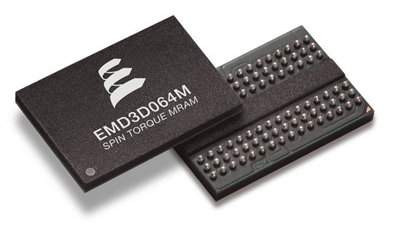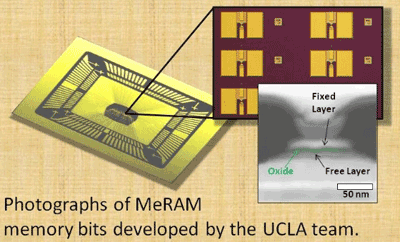
In this column will look at a few new memories available for your newest designs — with a little caution about real availability.
Everspin’s newest
In November Everspin Technologies introduced the first Spin-Torque Magnetoresistive RAM (ST-MRAM). The EMD3D064M 64 Mbit device is the first product in Everspin’s ST-MRAM planned product line. The device uses a DDR-3 type interface.
ST-MRAM uses a one-transistor, one-magnetic-tunnel junction (MTJ) memory cell. The MTJ is composed of a fixed magnetic layer, a thin dielectric tunnel barrier, and a free magnetic layer. When a bias is applied to the MTJ, electrons that are spin polarized by the magnetic layers traverse the dielectric barrier via tunneling. The MTJ has a low resistance when the magnetic moment of the free layer is parallel to the fixed layer and a high resistance when it is oriented anti-parallel to the fixed layer moment.

Everspin has been very verbose in its general description of their device — but very short on hard facts. ST-MRAM is not a real low-power technology, but since it is quick and nonvolatile, it can be turned off when not actually moving data around. Everspin says it is shipping working samples of this new memory to select customers and will announce details on broad availability in 2013. They provided no hard facts on power usage or access times.
MeRAM research at UCLA
Meanwhile, back in the lab, UCLA researchers have their own version of MRAM they call MeRAM, for magnetoelectric. The UCLA team has replaced spin transfer RAMs electric current with voltage to write data into the memory. This eliminates the need to move large numbers of electrons through wires and instead uses voltage do the switching. They say this results in it being 10 to 1,000 times more energy-efficient. Now, 10 to 1,000 is quite a range and hopfully thay can pin it down a bit more soon.
They also think their version can be more than five times as dense. The research team was led by principal investigator Kang L. Wang, UCLA’s Raytheon Professor of Electrical Engineering, and included lead author Juan G. Alzate, an electrical engineering graduate student, and Pedram Khalili, a research associate in electrical engineering and project manager for the UCLA–DARPA research programs in non-volatile logic.

The research was presented Dec. 12 in a paper called “Voltage-Induced Switching of Nanoscale Magnetic Tunnel Junctions” at the 2012 IEEE International Electron Devices Meeting in San Francisco.
New Micron memories
Micron Technology has announced the addition of a 512-Mbit phase change memory (PCM) plus 512 Mbit LPDDR2 memory multi-chip package device to its lineup. But, unfortunately, they provides no specifications, no part number, and no availability date. So, stay tuned and we’ll try to keep track of this device.
Back in August, we reported on Micron’s NOR flash ICs with 1-Gbit capacity. The N25Q SPI family offers fast quad I/O with 54 Mbyte/s read transfer rate at a 108 MHz clock rate and 500 Kbyte/s program speed. This device family runs from a puny 32-Mbit size up to this new 1- Gbit. Unfortunately, all I could find in distribution (here in late December) is the 256-Mbit version ($4.45 ea/single qty) and that’s in “limited supply”. So, it looks like you may have to wait a little bit for your 1 Gbit devices.
Cypress wireless F-RAM
The Cypress (from their Ramtron merger) MaxArias 4-/ 8-/16-Kbyte F-RAM secure wireless F-RAM memory solutions include EPC Gen-2 RFID access. These innovative Cypress devices allow system integrators to extend their RFID capabilities to create wireless databases that can store greater amounts of information locally on high-performance RF-enabled ICs. The WM71016 F-RAM performs reads and writes like a RAM and provides reliable data retention for 20 years while eliminating some of the complexities of EEPROM designs. Organized as 1,024 x 16 bits, the nonvolatile ferroelectric RAM yields virtually unlimited read/write endurance (>1e14) and gamma stability demonstrated to >30 kGy.

The WM71016s RF-enabled interface is compatible with the EPC Class-1 Generation-2 UHF Air Interface Protocol Standard at 860 to 960 MHz, Version 1.2.0. It comes in a standard IC package, wafer, bare dice, or as a fully tested ISO-18000-6C-compliant transponder antenna inlay.
The chip has a 96-bit electronic product code (EPC), a 32-bit access password, a 32-bit KILL password, and a 32-bit TID memory (factory programmed and locked). It will give you up to 640-Kbit/s read and 128-Kbit/s write transmission speeds. The IC works over –40° to 85°C and comes in an 8-pin UDFN package. Price in 100s is about $10.
Jim Harrison
Advertisement
Learn more about Electronic Products Magazine





